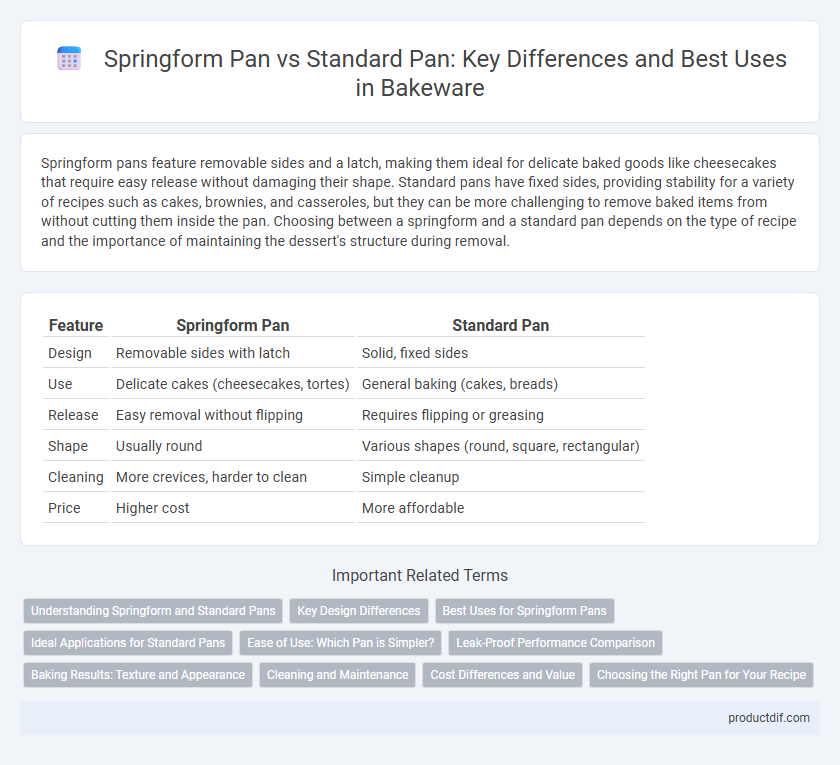Springform pans feature removable sides and a latch, making them ideal for delicate baked goods like cheesecakes that require easy release without damaging their shape. Standard pans have fixed sides, providing stability for a variety of recipes such as cakes, brownies, and casseroles, but they can be more challenging to remove baked items from without cutting them inside the pan. Choosing between a springform and a standard pan depends on the type of recipe and the importance of maintaining the dessert's structure during removal.
Table of Comparison
| Feature | Springform Pan | Standard Pan |
|---|---|---|
| Design | Removable sides with latch | Solid, fixed sides |
| Use | Delicate cakes (cheesecakes, tortes) | General baking (cakes, breads) |
| Release | Easy removal without flipping | Requires flipping or greasing |
| Shape | Usually round | Various shapes (round, square, rectangular) |
| Cleaning | More crevices, harder to clean | Simple cleanup |
| Price | Higher cost | More affordable |
Understanding Springform and Standard Pans
Springform pans feature removable sides held by a latch, ideal for delicate desserts like cheesecakes that require easy removal without inverting. Standard pans have fixed sides, making them versatile for a wide range of baked goods such as cakes, brownies, and casseroles. Choosing between springform and standard pans depends on the recipe's need for gentle release and the structural demands of the baked item.
Key Design Differences
Springform pans feature removable sides secured by a latch, allowing easy release of delicate cakes and cheesecakes without inverting the pan. Standard pans have fixed, non-removable sides, requiring the baked goods to be flipped or loosened manually for removal. The key design difference lies in the springform's adjustable sidewall versus the rigid construction of standard pans.
Best Uses for Springform Pans
Springform pans excel in baking delicate cheesecakes, tortes, and layered desserts that require careful removal without flipping. Their removable sides allow for easy release, preserving intricate shapes and preventing damage to fragile crusts. Ideal for recipes with soft or crumbly bases, springform pans enhance presentation and maintain structural integrity during serving.
Ideal Applications for Standard Pans
Standard pans are ideal for recipes requiring sturdy sides and easy flipping, such as cakes, brownies, and bar cookies. Their solid construction provides even heat distribution, promoting uniform baking and consistent texture. These pans work best for recipes that do not need delicate removal, making them perfect for layered cakes and dense baked goods.
Ease of Use: Which Pan is Simpler?
Springform pans offer greater ease of use for delicate desserts, featuring removable sides that allow cakes or cheesecakes to be released without flipping or damaging the shape. Standard pans require flipping or careful loosening to remove baked goods, increasing the risk of breakage or uneven edges. For bakers prioritizing convenience, especially with fragile recipes, the springform pan simplifies the process while maintaining the dessert's integrity.
Leak-Proof Performance Comparison
Springform pans feature removable sides secured by a latch, which can sometimes lead to minor leaks if not properly sealed, making them less reliable for batter-heavy recipes. Standard pans, with fixed walls and seamless construction, offer superior leak-proof performance ideal for custards, cheesecakes, and delicate batters. Selecting a high-quality springform pan with a secure, reinforced seal can minimize leaks, but standard pans generally provide better containment and stability during baking.
Baking Results: Texture and Appearance
Springform pans produce delicate cheesecakes and tortes with smooth, even edges due to their removable sides, enhancing presentation and maintaining structure without sticking. Standard pans yield firmer textures and more uniform browning, making them ideal for dense cakes and muffins where a consistent crust is desired. The choice between these pans significantly impacts the final texture and visual appeal of baked goods, with springform offering elegance and standard pans delivering robustness.
Cleaning and Maintenance
Springform pans feature removable sides that simplify cleaning by allowing easy access to every corner, preventing batter buildup and reducing residue. Standard pans often have fixed edges that can trap food particles, requiring more intensive scrubbing and soaking for thorough maintenance. Nonstick coatings on both types can extend lifespan with gentle hand washing, while harsh abrasives risk damaging surfaces and diminishing performance.
Cost Differences and Value
Springform pans typically cost more than standard pans due to their removable sides and locking mechanisms, which add complexity and material expenses. Despite the higher price, springform pans offer better value for delicate desserts like cheesecakes, allowing effortless removal without damage. Standard pans are more affordable and versatile for everyday baking but may lack the convenience and precision required for certain baked goods.
Choosing the Right Pan for Your Recipe
Selecting the right bakeware impacts the texture and ease of removal for delicate desserts; springform pans feature removable sides ideal for cheesecakes and layered cakes, preserving their shape during extraction. Standard pans, made from solid metal or silicone, offer uniform heat distribution and firmness, suitable for dense cakes and brownies that require sturdy support. Matching pan type to recipe specifics ensures optimal baking results and presentation quality.
Springform vs Standard Pan Infographic

 productdif.com
productdif.com